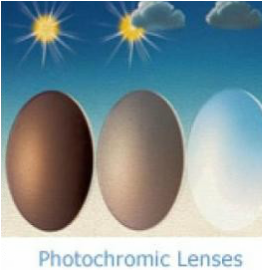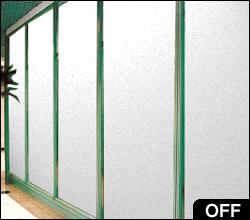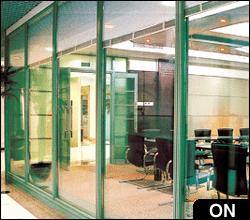Literature Review: Smart Glazing
"Active glazing can show a variety of chromic phenomena, that is, based on photochemical effects the glazing changes its light transmission properties in response to an environmental signal. This environmental signal can take several different forms such as light, temperature or voltage. There are many different technologies being developed within the field of smart glass and these include, but are not limited to, electrochromic, photochromic, gasochromic, thermochromic liquid crystal devices and suspended particle devices."
|
According to the Lawrence Berkeley National Laboratory, by actively managing lighting and cooling, smart windows could reduce peak electric loads by 20–30% in many commercial buildings, and increase day-lighting benefits while ensuring occupant comfort. (http://gaia.lbl.gov/hpbf/techno_d.htm). This is especially critical in offices given that thermal comfort is closely related to people’s productivity which can be altered if workers do not dwell in a pleasant environment.
|
 Source: www.christieglass.com
Source: www.christieglass.com
Energy requirements drive building design and windows play a key role in energy building performance. Designers choose glazing systems to maximize day-lighting but minimize glare as well as unwanted heat loss and gain. Glazing selection should be a careful process of evaluating and weighing trade offs as they are critical for day-lighting, occupant comfort and energy use. By adapting to their environment, dynamic facades could accommodate these multiple parameters while reducing energy consumption. In addition, saving energy means saving money and so there may be many advantages to dynamic glazing.
Photochromic glazing
Photochromic materials in glazing change reversibly in color depending on light intensity. These materials are colourless in a dark/dull environment but when exposed to sunlight or ultraviolet radiation the molecular structure withing the materials changes so that it exhibits colour. Once the light source is removed the color then disappears. An everyday example of this technology in practice would be the reversible photochromic reaction in color changing spectacles which change from clear to tinted lenses when exposed to the sun. |
Suspended Particle Devices & Liquid Crystal Devices
|
Suspended particle devices and liquid crystal devices work in similar ways. They typically consist of a thin film laminate of rod-like nano-particles suspended between two pieces of glass (or sometimes plastic). When there is no voltage applied the particles are randomly organized or in a chaotic state, which causes them to absorb light stopping it from penetrating the glass. However, when a voltage is applied the particles align to let light pass through. Varying this voltage across the film allows the alignment of the particles to be controlled and hence allows the user to control the tint of the glazing and therefore the amount of light transmitted though the glass.
|
Thermochromic Glazing
 http://www.commercialwindows.org
http://www.commercialwindows.org
Thermochromic materials used in window glazing are able to adapt their tint with varying levels of incident solar radiation in order to reduce solar heat gain in buildings. Ideally the layers of thermochromics material are continually altering their transmission over a range of temperatures and in doing so not only reduce solar heat gains but also maximize day-lighting. The façade is responsive to sunlight and utilizes the solar energy incident upon it to block the sun’s rays which would otherwise by passing through the window inducing a heat load on the building.
Electrochromic Glazing
As with thermochromic glass, electrochromic materials in glass are capable of changing their transmission properties. Instead of responding to temperature variations however, electrochromic glass responds to a small voltage being applied to it. This voltage allows the level of heat and light passing through it to be controlled. This type of technology requires an initial energy input in order to reach the desired level of opacity, but once this level is reached, no electricity is required to maintain this level of shade. Even when the glass is in a tinted state it maintains visibility and so occupants of the building will still have a view to the outdoors. This technology allows users to tune the glass to block out visible light, infrared radiation or both by varying the voltage across it and in doing so allows the room to maximize day-lighting while blocking a significant amount of the solar heat gains.
Within the scope of the project we chose two of these technologies to analyze in more depth, thermochromics and electrochromics.





